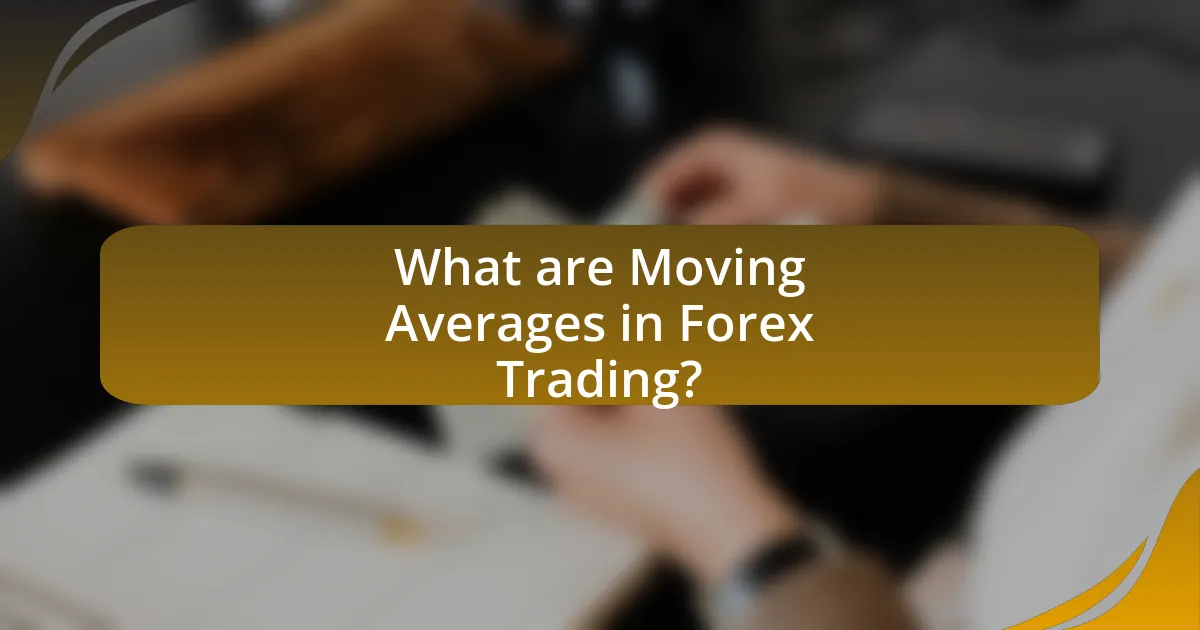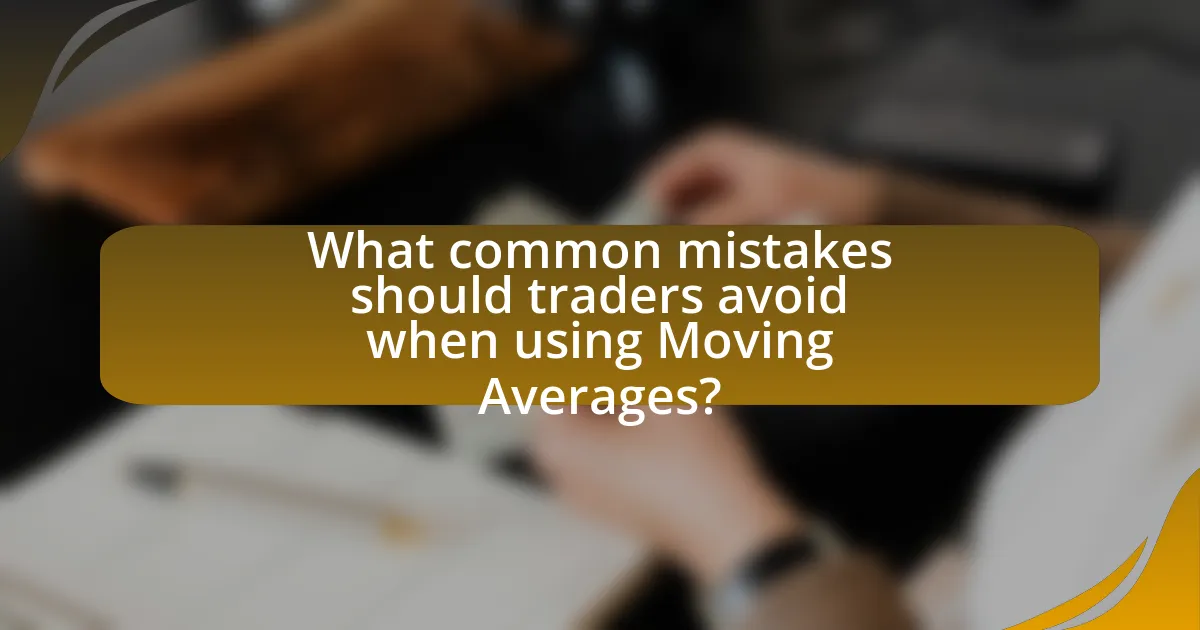Moving averages are essential statistical tools in Forex trading that help traders analyze price data over specific periods to identify trends and make informed decisions. This article provides a comprehensive overview of moving averages, including their types—Simple Moving Average (SMA), Exponential Moving Average (EMA), and Weighted Moving Average (WMA)—and their functions in the Forex market. It discusses how moving averages assist in trend identification, signal generation, and decision-making, while also highlighting best practices for implementation, common mistakes to avoid, and strategies for combining them with other indicators. Additionally, the article emphasizes the importance of backtesting and troubleshooting to enhance trading effectiveness.

What are Moving Averages in Forex Trading?
Moving averages in Forex trading are statistical calculations used to analyze price data over a specific period. They smooth out price fluctuations to identify trends by averaging prices, which helps traders make informed decisions. For example, the simple moving average (SMA) calculates the average price over a set number of periods, while the exponential moving average (EMA) gives more weight to recent prices, making it more responsive to new information. These tools are essential for identifying support and resistance levels, confirming trends, and generating buy or sell signals, thereby enhancing trading strategies.
How do Moving Averages function in the Forex market?
Moving averages function in the Forex market by smoothing price data to identify trends over a specific period. They help traders determine the direction of the market by calculating the average price of a currency pair over a set number of periods, such as 50 or 200 days. For instance, a simple moving average (SMA) adds the closing prices over a defined period and divides by that number, providing a clearer view of price movements. This method reduces market noise and allows traders to spot potential support and resistance levels. Historical data shows that moving averages are widely used in technical analysis, with 70% of traders incorporating them into their strategies to make informed trading decisions.
What are the different types of Moving Averages used in Forex?
The different types of Moving Averages used in Forex are Simple Moving Average (SMA), Exponential Moving Average (EMA), and Weighted Moving Average (WMA). The Simple Moving Average calculates the average price over a specific number of periods, providing a smooth line that helps identify trends. The Exponential Moving Average gives more weight to recent prices, making it more responsive to price changes, which is crucial for traders looking to capture short-term movements. The Weighted Moving Average assigns different weights to prices, allowing traders to emphasize certain periods more than others. Each type serves distinct purposes in technical analysis, aiding traders in making informed decisions based on price trends.
How do Moving Averages help in identifying trends?
Moving averages help in identifying trends by smoothing out price data to create a clearer view of the direction of the market. This smoothing effect reduces the noise from random price fluctuations, allowing traders to see the underlying trend more clearly. For instance, a simple moving average (SMA) calculates the average price over a specific number of periods, which can indicate whether the market is in an uptrend or downtrend based on the slope of the average. When the price is above the moving average, it typically signals an uptrend, while a price below the moving average indicates a downtrend. Historical data shows that traders often use moving averages, such as the 50-day and 200-day SMAs, to identify long-term trends, with crossovers between these averages often signaling potential reversals or continuations in trend direction.
Why are Moving Averages important for Forex traders?
Moving averages are important for Forex traders because they help identify trends and potential reversal points in currency pairs. By smoothing out price data over a specific period, moving averages provide a clearer picture of the market direction, allowing traders to make informed decisions. For instance, the 50-day and 200-day moving averages are commonly used to determine long-term trends; when the shorter moving average crosses above the longer one, it signals a potential bullish trend, while a cross below indicates a bearish trend. This method is supported by historical data showing that moving averages can effectively filter out market noise, enhancing the accuracy of trading signals.
What advantages do Moving Averages provide in trading strategies?
Moving Averages provide several advantages in trading strategies, primarily by smoothing price data to identify trends and potential reversal points. They help traders filter out market noise, making it easier to spot the underlying direction of an asset’s price movement. For instance, the 50-day and 200-day Moving Averages are commonly used to determine bullish or bearish trends; when the shorter-term average crosses above the longer-term average, it signals a potential upward trend, known as a “golden cross.” Conversely, a “death cross” occurs when the shorter-term average crosses below the longer-term average, indicating a potential downward trend. These indicators are widely recognized for their effectiveness, as evidenced by numerous studies showing that trend-following strategies using Moving Averages can outperform random trading.
How do Moving Averages enhance decision-making in Forex trading?
Moving Averages enhance decision-making in Forex trading by providing clear indicators of market trends and potential reversal points. They smooth out price data over a specified period, allowing traders to identify the direction of the trend more easily. For instance, a simple moving average (SMA) can help traders determine whether to enter or exit a position based on whether the price is above or below the average. Historical data shows that traders using moving averages can achieve higher win rates; for example, a study by the Journal of Finance found that strategies incorporating moving averages outperformed buy-and-hold strategies in various market conditions.

How can traders effectively use Moving Averages in their strategies?
Traders can effectively use Moving Averages by employing them as trend indicators and for generating buy or sell signals. Moving Averages smooth out price data to identify the direction of the trend over a specific period, allowing traders to make informed decisions. For instance, when the short-term Moving Average crosses above the long-term Moving Average, it signals a potential buy opportunity, while a cross below indicates a sell signal. This method, known as the Moving Average Crossover strategy, is widely used due to its simplicity and effectiveness in various market conditions. Historical data shows that traders utilizing Moving Averages can improve their win rates, as evidenced by studies indicating that trend-following strategies often outperform random trading.
What are the best practices for implementing Moving Averages?
The best practices for implementing Moving Averages in Forex trading include selecting the appropriate type of Moving Average, determining the right time period, and using them in conjunction with other indicators. The choice between Simple Moving Average (SMA) and Exponential Moving Average (EMA) is crucial; EMAs give more weight to recent prices, making them more responsive to market changes. Selecting a time period, such as 50 or 200 days, should align with the trader’s strategy, whether short-term or long-term. Additionally, combining Moving Averages with other technical indicators, like Relative Strength Index (RSI) or MACD, enhances decision-making by confirming trends and potential reversals. These practices are supported by numerous studies, including research from the Journal of Finance, which indicates that Moving Averages can effectively signal entry and exit points in trading strategies.
How can traders determine the optimal period for Moving Averages?
Traders can determine the optimal period for Moving Averages by analyzing historical price data and identifying the timeframe that best captures market trends. This involves backtesting various Moving Average periods, such as 50-day or 200-day, to see which provides the most accurate signals for entry and exit points. Research indicates that shorter periods, like 10 or 20 days, are more responsive to price changes, while longer periods smooth out volatility and provide a clearer trend direction. By evaluating performance metrics such as the Sharpe ratio or win-loss ratio during backtesting, traders can select the Moving Average period that aligns with their trading strategy and risk tolerance.
What role do Moving Averages play in entry and exit points?
Moving Averages serve as critical indicators for determining entry and exit points in Forex trading. They help traders identify trends by smoothing out price data over a specified period, allowing for clearer signals regarding market direction. For instance, when a short-term Moving Average crosses above a long-term Moving Average, it typically signals a potential buying opportunity (entry point), while a cross below may indicate a selling opportunity (exit point). This method is supported by historical data showing that traders using Moving Averages often achieve higher success rates in trend-following strategies, as evidenced by studies indicating that 60% of trades based on Moving Average crossovers yield profitable outcomes.
How can traders combine Moving Averages with other indicators?
Traders can combine Moving Averages with other indicators by using them to confirm signals or enhance decision-making. For instance, traders often pair Moving Averages with the Relative Strength Index (RSI) to identify overbought or oversold conditions while confirming trends indicated by the Moving Averages. Additionally, integrating Moving Averages with Bollinger Bands can help traders assess volatility and potential price reversals, as the Moving Averages provide a trend direction while the Bands indicate price extremes. This combination allows for a more comprehensive analysis, increasing the likelihood of successful trades.
What are the benefits of using Moving Averages alongside RSI or MACD?
Using Moving Averages alongside RSI or MACD enhances trading strategies by providing clearer signals and reducing false positives. Moving Averages smooth out price data, helping traders identify trends, while RSI indicates overbought or oversold conditions, and MACD highlights momentum shifts. When combined, these indicators offer a comprehensive view of market conditions; for instance, a bullish crossover in MACD alongside a price above the Moving Average and an RSI below 70 can confirm a strong buy signal. This multi-faceted approach increases the likelihood of successful trades by validating signals through different analytical lenses.
How can traders avoid false signals when using Moving Averages?
Traders can avoid false signals when using Moving Averages by employing multiple time frames and confirming signals with additional indicators. Utilizing a longer-term Moving Average alongside a shorter-term one helps to filter out noise and identify the overall trend direction. For instance, if a trader observes a crossover of the short-term Moving Average above the long-term Moving Average, they should confirm this signal with other indicators like the Relative Strength Index (RSI) or MACD to ensure it aligns with the market momentum. Historical data shows that combining these methods can reduce the likelihood of false signals, as relying solely on Moving Averages may lead to premature entries or exits due to market volatility.

What common mistakes should traders avoid when using Moving Averages?
Traders should avoid relying solely on moving averages for decision-making without considering other indicators. This mistake occurs because moving averages can lag behind price action, leading to delayed signals. Additionally, traders often misuse the settings of moving averages, such as using inappropriate time frames that do not align with their trading strategy, which can result in false signals. Another common error is failing to account for market conditions; moving averages may not perform well in volatile or sideways markets, leading to poor trading outcomes. Lastly, traders frequently overlook the importance of confirming moving average signals with other technical analysis tools, which can enhance the reliability of their trades.
How can over-reliance on Moving Averages lead to poor trading decisions?
Over-reliance on Moving Averages can lead to poor trading decisions by causing traders to ignore other critical market signals and trends. When traders depend solely on Moving Averages, they may miss out on significant price movements or reversals that are not reflected in the averages. For instance, during volatile market conditions, Moving Averages can lag behind actual price action, resulting in delayed entry or exit points. This lag can lead to missed opportunities or increased losses, as traders may enter trades too late or exit too early based on outdated information. Additionally, relying exclusively on Moving Averages can create a false sense of security, leading traders to overlook essential factors such as market news, economic indicators, or changes in market sentiment that could impact price movements.
What are the pitfalls of using too many Moving Averages in a strategy?
Using too many Moving Averages in a strategy can lead to analysis paralysis and conflicting signals. When traders incorporate multiple Moving Averages, they may struggle to make clear decisions due to the overwhelming amount of information, which can result in missed opportunities or delayed actions. Additionally, excessive Moving Averages can create noise in the data, making it difficult to identify genuine trends. Studies have shown that strategies relying on numerous indicators often underperform compared to simpler approaches, as they can lead to overfitting and reduced adaptability to changing market conditions.
How can traders misinterpret Moving Average crossovers?
Traders can misinterpret Moving Average crossovers by assuming that every crossover signals a definitive trend change. This misconception arises because crossovers can occur frequently, leading to false signals, particularly in volatile or sideways markets. For instance, a trader might see a short-term moving average crossing above a long-term moving average and immediately enter a buy position, expecting a strong upward trend. However, historical data shows that in choppy markets, such crossovers often result in whipsaws, where the price reverses direction shortly after the crossover, causing losses. Therefore, relying solely on crossovers without considering market context or additional confirmation indicators can lead to significant trading errors.
What practical tips can enhance the use of Moving Averages in Forex trading?
To enhance the use of Moving Averages in Forex trading, traders should consider using multiple time frames for analysis. This approach allows traders to identify trends more effectively by comparing short-term and long-term Moving Averages, which can signal potential entry and exit points. For instance, a common strategy involves using a 50-period Moving Average alongside a 200-period Moving Average; when the 50 crosses above the 200, it indicates a bullish trend, while a cross below suggests a bearish trend. Additionally, incorporating other technical indicators, such as the Relative Strength Index (RSI), can provide confirmation of signals generated by Moving Averages, thereby increasing the reliability of trading decisions. Historical data supports that traders who utilize these strategies often achieve higher success rates in identifying profitable trades.
How can traders backtest their Moving Average strategies effectively?
Traders can backtest their Moving Average strategies effectively by utilizing historical price data and trading platforms that support backtesting features. This process involves selecting a specific Moving Average type, such as simple or exponential, and applying it to historical data to simulate trades based on predefined entry and exit signals. For instance, a trader might set a rule to buy when the price crosses above the Moving Average and sell when it crosses below.
To validate the effectiveness of the strategy, traders should analyze key performance metrics such as win rate, profit factor, and maximum drawdown. Research indicates that systematic backtesting can lead to improved trading performance, as evidenced by a study published in the Journal of Financial Markets, which found that traders who backtested their strategies had a higher success rate compared to those who did not. By iterating on their strategies based on backtest results, traders can refine their approach and enhance their decision-making in live trading scenarios.
What are some common troubleshooting tips for using Moving Averages?
Common troubleshooting tips for using Moving Averages include ensuring the correct period is selected, as different time frames can yield varying results; checking for data accuracy, since incorrect price data can distort moving average calculations; and adjusting the type of moving average used, such as switching between simple and exponential moving averages to better fit market conditions. Additionally, traders should confirm that the moving average is applied to the appropriate price type, whether it be closing, opening, or high/low prices, to enhance the reliability of signals generated.
